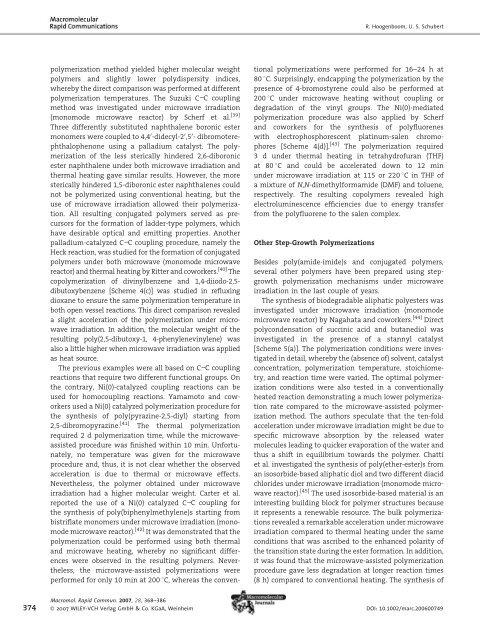Microwave-Assisted Polymer Synthesis: Recent Developments in a ...
Microwave-Assisted Polymer Synthesis: Recent Developments in a ...
Microwave-Assisted Polymer Synthesis: Recent Developments in a ...
Create successful ePaper yourself
Turn your PDF publications into a flip-book with our unique Google optimized e-Paper software.
R. Hoogenboom, U. S. Schubert<br />
polymerization method yielded higher molecular weight<br />
polymers and slightly lower polydispersity <strong>in</strong>dices,<br />
whereby the direct comparison was performed at different<br />
polymerization temperatures. The Suzuki C–C coupl<strong>in</strong>g<br />
method was <strong>in</strong>vestigated under microwave irradiation<br />
(monomode microwave reactor) by Scherf et al. [39]<br />
Three differently substituted naphthalene boronic ester<br />
monomers were coupled to 4,4 0 -didecyl-2 0 ,5 0 - dibromoterephthalophenone<br />
us<strong>in</strong>g a palladium catalyst. The polymerization<br />
of the less sterically h<strong>in</strong>dered 2,6-diboronic<br />
ester naphthalene under both microwave irradiation and<br />
thermal heat<strong>in</strong>g gave similar results. However, the more<br />
sterically h<strong>in</strong>dered 1,5-diboronic ester naphthalenes could<br />
not be polymerized us<strong>in</strong>g conventional heat<strong>in</strong>g, but the<br />
use of microwave irradiation allowed their polymerization.<br />
All result<strong>in</strong>g conjugated polymers served as precursors<br />
for the formation of ladder-type polymers, which<br />
have desirable optical and emitt<strong>in</strong>g properties. Another<br />
palladium-catalyzed C–C coupl<strong>in</strong>g procedure, namely the<br />
Heck reaction, was studied for the formation of conjugated<br />
polymers under both microwave (monomode microwave<br />
reactor) and thermal heat<strong>in</strong>g by Ritter and coworkers. [40] The<br />
copolymerization of div<strong>in</strong>ylbenzene and 1,4-diiodo-2,5-<br />
dibutoxybenzene [Scheme 4(c)] was studied <strong>in</strong> reflux<strong>in</strong>g<br />
dioxane to ensure the same polymerization temperature <strong>in</strong><br />
both open vessel reactions. This direct comparison revealed<br />
a slight acceleration of the polymerization under microwave<br />
irradiation. In addition, the molecular weight of the<br />
result<strong>in</strong>g poly(2,5-dibutoxy-1, 4-phenylenev<strong>in</strong>ylene) was<br />
also a little higher when microwave irradiation was applied<br />
as heat source.<br />
The previous examples were all based on C–C coupl<strong>in</strong>g<br />
reactions that require two different functional groups. On<br />
the contrary, Ni(0)-catalyzed coupl<strong>in</strong>g reactions can be<br />
used for homocoupl<strong>in</strong>g reactions. Yamamoto and coworkers<br />
used a Ni(0) catalyzed polymerization procedure for<br />
the synthesis of poly(pyraz<strong>in</strong>e-2,5-diyl) start<strong>in</strong>g from<br />
2,5-dibromopyraz<strong>in</strong>e. [41] The thermal polymerization<br />
required 2 d polymerization time, while the microwaveassisted<br />
procedure was f<strong>in</strong>ished with<strong>in</strong> 10 m<strong>in</strong>. Unfortunately,<br />
no temperature was given for the microwave<br />
procedure and, thus, it is not clear whether the observed<br />
acceleration is due to thermal or microwave effects.<br />
Nevertheless, the polymer obta<strong>in</strong>ed under microwave<br />
irradiation had a higher molecular weight. Carter et al.<br />
reported the use of a Ni(0) catalyzed C–C coupl<strong>in</strong>g for<br />
the synthesis of poly(biphenylmethylene)s start<strong>in</strong>g from<br />
bistriflate monomers under microwave irradiation (monomode<br />
microwave reactor). [42] It was demonstrated that the<br />
polymerization could be performed us<strong>in</strong>g both thermal<br />
and microwave heat<strong>in</strong>g, whereby no significant differences<br />
were observed <strong>in</strong> the result<strong>in</strong>g polymers. Nevertheless,<br />
the microwave-assisted polymerizations were<br />
performed for only 10 m<strong>in</strong> at 200 8C, whereas the conventional<br />
polymerizations were performed for 16–24 h at<br />
80 8C. Surpris<strong>in</strong>gly, endcapp<strong>in</strong>g the polymerization by the<br />
presence of 4-bromostyrene could also be performed at<br />
200 8C under microwave heat<strong>in</strong>g without coupl<strong>in</strong>g or<br />
degradation of the v<strong>in</strong>yl groups. The Ni(0)-mediated<br />
polymerization procedure was also applied by Scherf<br />
and coworkers for the synthesis of polyfluorenes<br />
with electrophosphorescent plat<strong>in</strong>um-salen chromophores<br />
[Scheme 4(d)]. [43] The polymerization required<br />
3 d under thermal heat<strong>in</strong>g <strong>in</strong> tetrahydrofuran (THF)<br />
at 80 8C and could be accelerated down to 12 m<strong>in</strong><br />
under microwave irradiation at 115 or 220 8C <strong>in</strong> THF of<br />
a mixture of N,N-dimethylformamide (DMF) and toluene,<br />
respectively. The result<strong>in</strong>g copolymers revealed high<br />
electrolum<strong>in</strong>escence efficiencies due to energy transfer<br />
from the polyfluorene to the salen complex.<br />
Other Step-Growth <strong>Polymer</strong>izations<br />
Besides poly(amide-imide)s and conjugated polymers,<br />
several other polymers have been prepared us<strong>in</strong>g stepgrowth<br />
polymerization mechanisms under microwave<br />
irradiation <strong>in</strong> the last couple of years.<br />
The synthesis of biodegradable aliphatic polyesters was<br />
<strong>in</strong>vestigated under microwave irradiation (monomode<br />
microwave reactor) by Nagahata and coworkers. [44] Direct<br />
polycondensation of succ<strong>in</strong>ic acid and butanediol was<br />
<strong>in</strong>vestigated <strong>in</strong> the presence of a stannyl catalyst<br />
[Scheme 5(a)]. The polymerization conditions were <strong>in</strong>vestigated<br />
<strong>in</strong> detail, whereby the (absence of) solvent, catalyst<br />
concentration, polymerization temperature, stoichiometry,<br />
and reaction time were varied. The optimal polymerization<br />
conditions were also tested <strong>in</strong> a conventionally<br />
heated reaction demonstrat<strong>in</strong>g a much lower polymerization<br />
rate compared to the microwave-assisted polymerization<br />
method. The authors speculate that the ten-fold<br />
acceleration under microwave irradiation might be due to<br />
specific microwave absorption by the released water<br />
molecules lead<strong>in</strong>g to quicker evaporation of the water and<br />
thus a shift <strong>in</strong> equilibrium towards the polymer. Chatti<br />
et al. <strong>in</strong>vestigated the synthesis of poly(ether-ester)s from<br />
an isosorbide-based aliphatic diol and two different diacid<br />
chlorides under microwave irradiation (monomode microwave<br />
reactor). [45] The used isosorbide-based material is an<br />
<strong>in</strong>terest<strong>in</strong>g build<strong>in</strong>g block for polymer structures because<br />
it represents a renewable resource. The bulk polymerizations<br />
revealed a remarkable acceleration under microwave<br />
irradiation compared to thermal heat<strong>in</strong>g under the same<br />
conditions that was ascribed to the enhanced polarity of<br />
the transition state dur<strong>in</strong>g the ester formation. In addition,<br />
it was found that the microwave-assisted polymerization<br />
procedure gave less degradation at longer reaction times<br />
(8 h) compared to conventional heat<strong>in</strong>g. The synthesis of<br />
374<br />
Macromol. Rapid Commun. 2007, 28, 368–386<br />
ß 2007 WILEY-VCH Verlag GmbH & Co. KGaA, We<strong>in</strong>heim<br />
DOI: 10.1002/marc.200600749
















